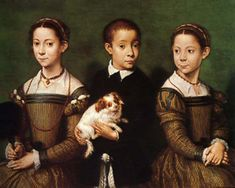Brotherly bonds
by Mila Prol
Sofonisba Anguissola - "Three children with dog" (1570)
In this novel, Maggie O'Farrell depicts, masterfully and delicately,true fraternal relationships between siblings that go beyond life. As Agnes and Bartholomeu grow up in a hostile environment, she has the urge to protect him from his stepmother.
“She grows up knowing that she must protect and defend Bartholomew from all of life’s blows, because no one else will.”
Equally, when she falls in love with that “useless and beardless lad,” according to her stepmother, Bartholomew corresponds to her tenderness by being watchful of her future well-being:
“Take good care of her, Latin boy, very good care, and no harm will come to you.”
Correspondingly, he will abandon his farm and family duties to accompany his sister on her trip to London, where uncertainty awaits her.
Similarly, when a young Hamnet is desperately in search of an adult to aid his ill twin sister, Judith, as death looms imminently, he doesn’t doubt to give his life for hers, in an act of true love and sacrifice.
“It will be easy for Death to make a mistake, to take him in her place.”
As a result of this tragedy, the feeling of being incomplete will invade Judith’s life.
“What is the word, Judith asks her mother, for someone who was a twin but is no longer a twin?”
Bartholomew and Hamnet are the omniscient protectors of their sisters, always there, if needed, always in their memory.








